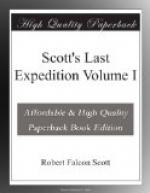Wednesday, November 29.—Camp 25. Lat. 82 deg. 21’. Things much better. The land showed up late yesterday; Mount Markham, a magnificent triple peak, appearing wonderfully close, Cape Lyttelton and Cape Goldie. We did our march in good time, leaving about 4.20, and getting into this camp at 1.15. About 7 1/2 hours on the march. I suppose our speed throughout averages 2 stat. miles an hour.
The land showed hazily on the march, at times looking remarkably near. Sheety white snowy stratus cloud hung about overhead during the first march, but now the sky is clearing, the sun very warm and bright. Land shows up almost ahead now, our pony goal less than 70 miles away. The ponies are tired, but I believe all have five days’ work left in them, and some a great deal more. Chinaman made four feeds for the dogs, and I suppose we can count every other pony as a similar asset. It follows that the dogs can be employed, rested, and fed well on the homeward track. We could really get though now with their help and without much delay, yet every consideration makes it desirable to save the men from heavy hauling as long as possible. So I devoutly hope the 70 miles will come in the present order of things. Snippets and Nobby now walk by themselves, following in the tracks well. Both have a continually cunning eye on their driver, ready to stop the moment he pauses. They eat snow every few minutes. It’s a relief not having to lead an animal; such trifles annoy one on these marches, the animal’s vagaries, his everlasting attempts to eat his head rope, &c. Yet all these animals are very full of character. Some day I must write of them and their individualities.
The men-haulers started 1 1/2 hours before us and got here a good hour ahead, travelling easily throughout. Such is the surface with the sun on it, justifying my decision to work towards day marching. Evans has suggested the word ‘glide’ for the quality of surface indicated. ‘Surface’ is more comprehensive, and includes the crusts and liability to sink in them. From this point of view the surface is distinctly bad. The ponies plough deep all the time, and the men most of the time. The sastrugi are rather more clearly S.E.; this would be from winds sweeping along the coast. We have a recurrence of ’sinking crusts’—areas which give way with a report. There has been little of this since we left One Ton Camp until yesterday and to-day, when it is again very marked. Certainly the open Barrier conditions are different from those near the coast. Altogether things look much better and everyone is in excellent spirits. Meares has been measuring the holes made by ponies’ hooves and finds an average of about 8 inches since we left One Ton Camp. He finds many holes a foot deep. This gives a good indication of the nature of the work. In Bowers’ tent they had some of Chinaman’s undercut in their hoosh yesterday, and say it was excellent. I am cook for the present. Have been discussing pony snowshoes. I wish to goodness the animals would wear them—it would save them any amount of labour in such surfaces as this.




